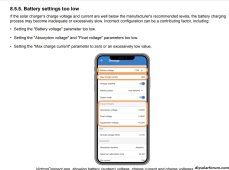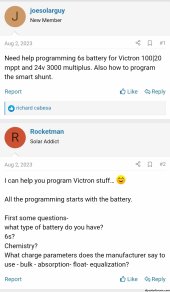JazzRVwSolar
New Member
The wattage and voltage tests were done in July/Aug. Yes, the tester was confirmed against a bench DC power supply up to its max 30V and 10A rating. I have no reason to believe that it would not continue to behave up to its 800W Max. Yes the voltages Voc and Isc were measured. I have no way to produce higher regulated volts/amps.How does this not make a difference?
So, you did this manually, with the panel perfectly perpendicular to the sun at high noon?
Is this tool reliable? Have you correlated it to other systems? Have you confirmed panel performance with manual measurements?
To get 330-350W out of a 375W panel this time of year in the northern hemisphere is a tall tale. I have 330W panels tilted at 29° in a cold climate. They only produce about 278W this time of year.
And this was at high noon with the panels perfectly perpendicular to the sun, no shading and clear skies?
Perhaps from your perspective, but many of us on here trying to give advice want to ensure we have a working knowledge of the system.
"Fully programmable" means different things to different people, but in this context, as I indicated, the MPPT is capable of outputting 480W @ 24V.
If your panels are flat on your roof, and you're getting 270-290W out of them, that's fantastic for this time of year assuming you're in the Northern hemisphere.
According to the DC wattage test tool, the panel was producing 330 - 350W. During that time, the MPPT was reporting Max Wattage of 270 - 290.
The 330 - 350W was measure at the point of the wires which go into the SCC. This eliminates all questions about line loss, solar irradiance, tilt, etc. The SCC mode was Bulk. The voltage was low of 20V to high of 24V.
To the best of my knowledge the SCC for bulk is/was set at Bulk charge Voltage of 24V and no limit set to current. In BULK and those parameters I would expect that at a battery voltage of 20 and a charge voltage of 24, for example, there should have been 330W/20V = 16.5A to 350/20 17.5A going to the battery. In reality we were seeing half.
270/330 or 290/350 that puts the SCC at efficiency of 80%. This is 10% below the minimum number claimed, which is 90 - 99%.
The only thing I have every been told by supposed solar professional (who is not a fan of Victron, btw) is that most SCC work best if Solar Voltage is at least 5V above the battery voltage. And efficiency increases, if the battery voltage is not that much further below the optimal tracking point - maybe 2 - 3V. His thought was that if mppt was 37V and battery was 20V, the gap was too big and so the unit was not able to function. I explained that this was programmed and showed him. He said it's too "damn complicated crap," which is why he didn't fool with it.
Last edited:




